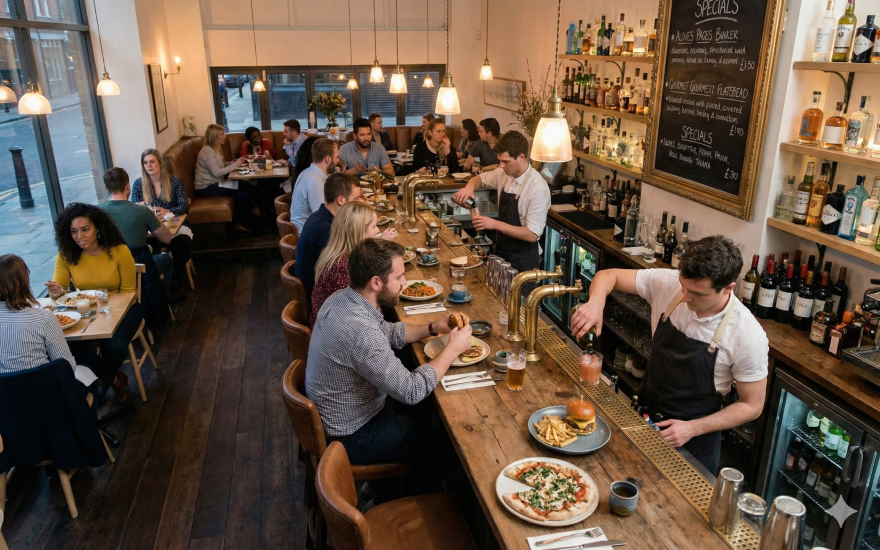Cost Avoidance vs Cost Savings in Restaurants: What’s the Difference?

Running a restaurant today means operating on incredibly tight margins. Every dollar saved or avoided makes the difference between thriving and just staying afloat. Yet, many operators use the terms cost avoidance and cost savings interchangeably, which can create confusion and missed opportunities to maximize profitability.
Why Does Cost Avoidance vs Cost Savings Matter for Restaurants Today?
Restaurants continue to operate under increasing financial stress. According to the National Restaurant Association, average profit margins in the industry hover at just 3–5%. On top of that, labor alone accounts for 30–35% of expenses, making it the single biggest controllable cost category.
Given those numbers, it is not surprising that operators are looking for every opportunity to cut waste and boost efficiency. The challenge? Many are focusing only on short-term cost savings while overlooking the long-term benefits of cost avoidance. Both are essential, but they serve different purposes:
- Cost savings reduce expenses today in ways that show up directly on the profit-and-loss statement.
- Cost avoidance prevents costs from showing up tomorrow by addressing potential risks before they lead to financial impact.
Understanding how to balance these two strategies is critical to surviving — and thriving — in an environment where a few percentage points in efficiency can be the difference between profitability and loss.
What Is Cost Avoidance in a Restaurant?
Cost avoidance refers to the practice of preventing expenses before they occur. While it does not always appear on financial reports in a straightforward way, its impact is real because it removes potential risks and reduces exposure to unnecessary future costs.
For restaurants, these situations often involve proactive investments. For instance:
- Scheduling preventive maintenance on kitchen equipment avoids expensive emergency breakdowns.
- Investing in energy-efficient appliances reduces long-term utility bills.
- Providing compliance or food safety training prevents fines and legal costs.
Restaurant Examples of Cost Avoidance
- Preventive equipment maintenance: A commercial fryer or walk-in cooler breakdown during service can lead not only to repair costs but also to food spoilage and lost sales. Regular maintenance helps avoid these cascading costs.
- Safety and compliance training: Failing to invest in training increases the risk of workplace accidents or fines from health inspections. Proactive training programs avoid these costs before they occur.
- Technology investments: Workforce analytics can help predict costly overtime. By identifying troublesome scheduling patterns, managers can avoid budget overruns due to unplanned labor costs.
Although the benefits of avoidance may not always be tangible in a monthly profit and loss (P&L) statement, the savings often accumulate significantly over time. According to the U.S. Department of Energy, businesses can save 12–18% by adopting preventive maintenance instead of relying on reactive repairs.
What Is Cost Savings in a Restaurant?
Cost savings, on the other hand, represent actual reductions in spending that are directly visible in financial reports. These are the “hard” numbers that every operator can point to when showing improvement in efficiency.
Common examples of cost savings include:
- Renegotiating vendor contracts to reduce food and beverage purchasing costs.
- Implementing smarter scheduling with workforce management software.
- Streamlining payroll processes to reduce administrative expenses.
Cost Savings vs. Soft Savings
- Hard savings are reductions that appear directly in the budget, such as negotiating lower supplier prices.
- Soft savings include less tangible but equally valuable benefits such as employee time savings, improved staff morale, or reduced turnover — all of which affect overall profitability in the long run.
For restaurants, clear cost savings often provide the immediate relief needed to stay on budget, while soft savings contribute indirectly to sustainable operations. Both play an essential role in competitive hospitality environments.
Why Are Cost Avoidance and Cost Savings Often Confused?
The terms often overlap in conversation because both focus on protecting profitability through smarter spending decisions. However, the difference lies in timing and measurability:
- Cost savings impact the bottom line today.
- Cost avoidance protects the bottom line tomorrow.
In fast-paced restaurant environments, immediate results tend to get more attention. Yet operators who overlook cost avoidance risk dealing with expensive emergencies later. For example, cutting corners on equipment upkeep to “save money” could result in a costly failure during peak service, undermining initial savings.
Restaurants that combine short-term budget improvements with long-term protection strategies build resilience, balancing today’s financial needs with tomorrow’s sustainability.
How Can Restaurants Use Cost Avoidance Strategies Effectively?
Cost avoidance is about foresight, planning, and proactive investment in areas that reduce risk exposure.
Some effective strategies include:
- Kitchen and HVAC maintenance: Scheduling regular service avoids emergency repairs and downtime that can cost thousands.
- Food safety and compliance programs: Investing in proactive training minimizes the risk of fines, lawsuits, or health inspection closures.
- Workforce forecasting: Using data to anticipate overtime or labor shortages allows management to adjust schedules before costs spiral out of control.
These approaches require discipline, especially when budgets are tight, but their long-term payoffs are significant. Restaurants that commit to preventive practices enjoy greater operational stability and reduce unexpected financial shocks that often derail progress.
How Can Restaurants Drive Measurable Cost Savings?
Restaurants also need cost savings that directly improve financial statements. Effective cost-cutting starts with identifying key expense areas and implementing smarter processes.
Some proven cost saving tactics include:
- Renegotiating supplier contracts: Lowering the cost per unit of food or beverage purchases adds up significantly over time.
- Automated scheduling systems: Workforce management tools, such as Push Operations, help eliminate inefficient manual scheduling. This prevents costly overstaffing, reduces overtime, and creates better labor alignment with sales forecasts.
- Reducing turnover through better retention: High employee turnover is a hidden cost in restaurants, driving up recruitment and training expenses. Investing in onboarding and supportive staff systems helps reduce these recurring expenditures.
Cost Savings Examples for Restaurants
- Automated scheduling: Smarter scheduling can reduce unnecessary labor expenses while still meeting guest demands.
- Energy management: Small adjustments in appliance use and facility energy consumption add up to consistent budget savings.
By targeting these areas, restaurants can see results reflected immediately, often within the same quarter.
What’s the Impact of Cost Avoidance vs Cost Savings on Profitability?
The combined effect of cost avoidance and cost savings cannot be overstated. With profit margins averaging only 3–5%, even minor financial improvements can significantly change the bottom line. For example:
- Preventing unplanned overtime (avoidance) combined with reducing scheduling errors (savings) directly impacts labor efficiency.
- Proactive maintenance (avoidance) prevents expensive breakdowns that could wipe out a month’s worth of “savings.”
Since labor makes up 30–35% of total costs, balancing avoidance and savings in staffing decisions provides one of the most powerful levers for improving profitability. Restaurants that fail to integrate cost avoidance with cost savings may end up focusing only on immediate wins, while overlooking longer-term efficiency strategies that keep operations sustainable.
How Should Restaurants Measure Cost Avoidance and Cost Savings?
Tracking results is critical to ensure both strategies deliver value. The challenge lies in the difference between the two:
- Measuring cost savings: These are straightforward and appear clearly in budget reports and P&L statements. Examples include lower vendor costs or fewer overtime hours.
- Measuring cost avoidance: These require more analysis and projections. For example, savings on avoided equipment repairs or avoided fines may not show up directly, but can be estimated based on what would have occurred without preventive measures.
Restaurants can succeed by tracking both through workforce management systems and financial reporting tools. Doing so helps managers balance today’s measurable wins against tomorrow’s avoided costs, offering a complete picture of operational efficiency.
What Are Practical Tips for Balancing Both Approaches?
To maximize profitability, restaurants should create systems that integrate avoidance and savings strategies. Practical steps include:
- Build a cost management culture: Encourage managers and staff to look beyond immediate expenses and think about long-term protection strategies.
- Set key performance indicators (KPIs): Track metrics around labor efficiency, maintenance schedules, and savings goals.
- Leverage workforce technology: Real-time insights from tools like Push Operations help operators balance staff allocation, prevent overtime, and improve payroll accuracy across both cost categories.
By balancing proactive measures with real-time budget impacts, restaurants can achieve a healthier bottom line while building resilience for the future.
Conclusion: Balancing Cost Avoidance and Cost Savings for Success
In restaurants, operating margins are thin and competition is fierce. Mastering the difference between cost avoidance vs cost savings allows owners, operators, and HR managers to not only survive but to plan sustainably for growth. While cost savings deliver immediate, measurable relief, avoiding future expenses ensures long-term stability.
For restaurant teams, the biggest opportunities to integrate both strategies exist in labor management, compliance, and equipment upkeep. Technology platforms like Push Operations make it easier to forecast labor costs, reduce administrative overhead, and create balance between proactive cost avoidance and direct cost savings.
Ready to improve margins and gain control of labor costs? Book a demo with Push Operations today and discover how smarter scheduling and payroll management can help your restaurant find the perfect balance between avoiding costs and saving them.



